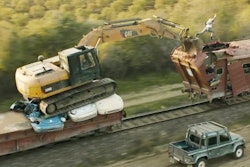More ways to save and reuse water are being employed in landscape design.
With the rise of municipal water restrictions and push for sustainable practices, more contractors and designers are employing rainwater harvesting in landscaping projects across the country.
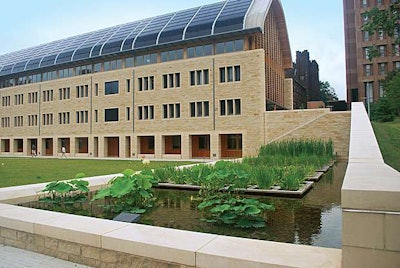 Nitsch Engineering designed this rainwater harvesting system for Yale’s Kroon Hall, which uses a water garden to filter water captured from the roof and grounds.
Nitsch Engineering designed this rainwater harvesting system for Yale’s Kroon Hall, which uses a water garden to filter water captured from the roof and grounds.Be it collected from a roof or land area, rainwater is diverted and saved for future purposes such as irrigation. Systems vary in sophistication from rain barrels collecting water from downspouts to extensive passive-onsite-chamber systems.
“Until recently, many people viewed rainwater harvesting as something done only in third world countries,” says Nicole Holmes, project manager at Nitsch Engineering in Boston, Massachusetts. “But the scarcity of water in arid and coastal states, along with the overall sustainability movement, have made the process more mainstream.”
We spoke to several professionals with expertise in rainwater harvesting to learn why its popularity is likely to grow. They say if you’re considering add-on services for your business, this may be one to look into.
Nicole Holmes, PE
Project Manager, Nitsch Engineering
Multi-disciplined firm offering civil engineering, planning and sustainable consulting services
Boston, Massachusetts
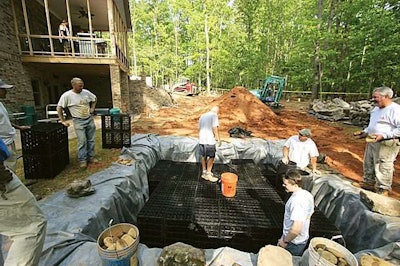
The system channels water from the roof and grounds to a water garden in the south courtyard, where aquatic plants filter out sediment and contaminants. The treated rainwater, held in underground storage tanks, is then pumped back into Kroon for flushing toilets, irrigation and to re-circulate through the water garden. The system saves about 500,000 gallons of water annually and reduces the burden on sewers by lessening runoff.
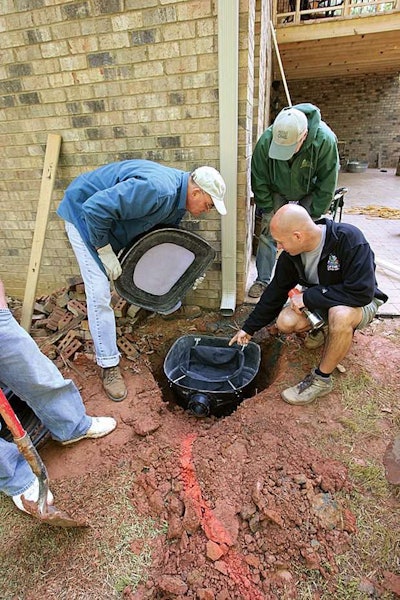
“Higher-education institutions are demonstrating their leadership in responsible water management by integrating rainwater harvesting in recent projects,” Holmes says. “Campus landscapes and buildings use significant quantities of water, and many of the intended water uses do not require potable water. Irrigation, for example, is a prime example of a large-water use that can be met using non-potable water from captured rainwater or grey water.”
In areas like the Northeast, water is extremely cheap and often taken for granted. But projections show that is going to change, Holmes says. More regulations are being put in place to manage storm water runoff, and recognition programs, such as the LEED rating system, include elements such as stormwater management and water conservation.
Lori Beehner
Project Manager, Environmental Construction
Full-service landscape company
Seattle, Washington
Even in one of the wettest cities in the country, Environmental Construction is installing rainwater-harvesting systems to area homes. But there, it’s more about mitigating runoff water than providing irrigation in times of drought (although collected water is used in the less-rainy summer months for irrigation).
This rainwater harvesting system with pondless waterfall by Aquascape has, among other features, a rain filter below a downspout feeding a modular storage basin (top right).
“The Pacific Northwest is known for its mountains, salmon, coffee and rain,” Beehner says. “One of the most important challenges we face is determining the best techniques to deal with a sudden influx of rainwater.”Catching and storing rainwater in above or underground tanks or even simple barrels for future use allows homeowners the luxury of watering their lawns and gardens during the drier summer months without guilt and mitigates runoff.
When installing a rainwater-harvesting system, Beehner and her team approach run-off issues in several manners. Sometimes overflow is directed to a French drain or rain garden with water-loving, indigenous plants. Or they might employ an underground tank system attached to the municipal water system with a backflow preventer to ensure no tank-stored water enters the city water supply.
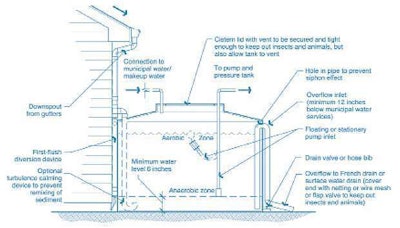 Residential system by Heather Kinkade
Residential system by Heather KinkadeBeehner learned how to install systems through courses at her community college and training offered by the city of Seattle. “The basic techniques are easy to learn, but it is always best to consult a professional when pursuing a large water harvesting system,” she says. “With the depleting water resources worldwide, water harvesting and conservation are becoming our future.”
Heather Kinkade
Executive Director, American Rainwater Catchment Systems Association (ARCSA)
A nonprofit organization that promotes rainwater catchment systems in the United States
Phoenix, Arizona
Registered landscape architect Heather Kinkade became interested in rainwater harvesting 10 years ago while designing the campus of a shopping mall in Phoenix. The client wanted to remove a retention pond from the plans to incorporate more parking. Kinkade added underground tanks and pipes to redirect runoff, freeing up the needed parking space.
“At the time, it wasn’t about sustainability. It was a land-use issue,” Kinkade says.
“We need to take care of our water supplies and use them wisely.”
But during the years, she has become passionate about rainwater harvesting and sustainable practices. She has even written several books on the subject and teaches landscape architecture at Arizona State University where rainwater harvesting is a required course.
Students from her class recently designed several projects at Desert Garden Montessori School in Phoenix where collected rainwater is used to nourish campus vegetable and herb gardens. The systems are simple and include rain gardens and active catchments with tanks that are used to teach students (as well as teachers and parents) the importance of being good stewards of the environment.
Kinkade suggests landscape contractors who want to incorporate rainwater harvesting into their designs first take an ARCSA 100-level workshop for insight to the process (find ARCSA workshops in your area at arcsa.org).
“It has been shown in other countries that fresh water supplies should not be taken for granted,” she says. “We need to take care of our water supplies and use them wisely. Rainwater catchment and reuse is a smart use of water.”
Market the Benefits
• Rainwater is slightly acidic, thus better for your plants.
• Capturing rainwater helps mitigate storm- water runoff that can pollute waterways.
• It typically saves clients money on water bills.
• Reduces flooding and erosion.
• It is a component of LEED certification.
• Harvesting rainwater provides a water source for landscapes even when water use is restricted.




